As an Amazon Associate KitchenwareSets.com earns from qualifying purchases.
9 Essential Japanese Kitchenware Tools for Every Home Chef
Have you ever meticulously followed a recipe for ramen or tonkatsu, only for the final dish to lack that certain something—that authentic texture and depth of flavor you remember from your favorite Japanese restaurant? It can be frustrating to put in the effort and still feel like you’re missing a secret ingredient. You start to wonder if it’s a lack of skill or a complex technique that’s just beyond a home cook’s reach.
You’ve sourced high-quality ingredients, perfected your timing, and even plated it beautifully, yet the results are still not quite right. The rice might be slightly too sticky, the broth isn’t perfectly clear, or the ginger doesn’t have that potent, fresh kick. This gap between your cooking and the authentic experience often comes down to the tools you use. Standard Western kitchenware, while versatile, isn’t always designed for the specific tasks and techniques that are fundamental to Japanese cuisine.
Achieving authentic Japanese flavors at home goes beyond recipes; it involves using specialized kitchenware designed for precision and tradition. Essential tools like a high-quality Santoku knife, a Donabe pot, and a Suribachi mortar are not just gadgets; they are purpose-built instruments that significantly enhance texture, flavor, and presentation, bridging the gap between a good meal and an unforgettable one. As a passionate home cook dedicated to mastering Japanese cuisine, I’ve discovered that certain tools aren’t just helpful—they’re transformative. This guide is built on years of testing and finding what truly makes a difference.
Why Do Authentic Japanese Dishes Taste Better? The Secret Might Be in the Tools
Achieving authentic Japanese flavors at home goes beyond recipes; it involves using specialized kitchenware designed for precision and tradition. Essential tools like a high-quality Santoku knife, a Donabe pot, and a Suribachi mortar significantly enhance texture, flavor, and presentation. The difference often lies in how these tools handle ingredients. A Japanese grater, for instance, creates a fine paste that releases more flavor from ginger than a standard microplane, while a Hangiri bowl absorbs excess moisture from rice, giving it the perfect texture for sushi. These seemingly small details, when combined, are what elevate a homemade dish to restaurant quality. As a passionate home cook dedicated to mastering Japanese cuisine, I’ve discovered that certain tools aren’t just helpful—they’re transformative. This guide is built on years of testing and finding what truly makes a difference.
9 Essential Japanese Kitchenware Tools to Elevate Your Cooking in 2025
The foundational kit for any home chef serious about Japanese cooking includes nine key pieces of kitchenware chosen for their specific functions and impact on the final dish. This curated list moves beyond the basics to include tools that are mainstays in Japanese households for a reason. From the precision of a Santoku knife to the communal experience of a Donabe pot, each item serves a distinct purpose that standard equipment can’t quite replicate. This curated list is based on recommendations from professional chefs and seasoned Japanese home cooks, ensuring each tool is both authentic and highly practical for a modern kitchen.
Here is the essential list:
1. High-Quality Chef’s Knife (Santoku/Gyuto)
2. Electric Rice Cooker
3. Suribachi and Surikogi (Mortar and Pestle)
4. Fine Mesh Skimmer
5. Otoshibuta (Drop Lid)
6. Hangiri (Sushi Oke)
7. Long Cooking Chopsticks (Saibashi)
8. Japanese Grater (Oroshigane)
9. Donabe (Earthenware Pot)
1. The Precision Blade: High-Quality Japanese Chef’s Knife (Santoku or Gyuto)
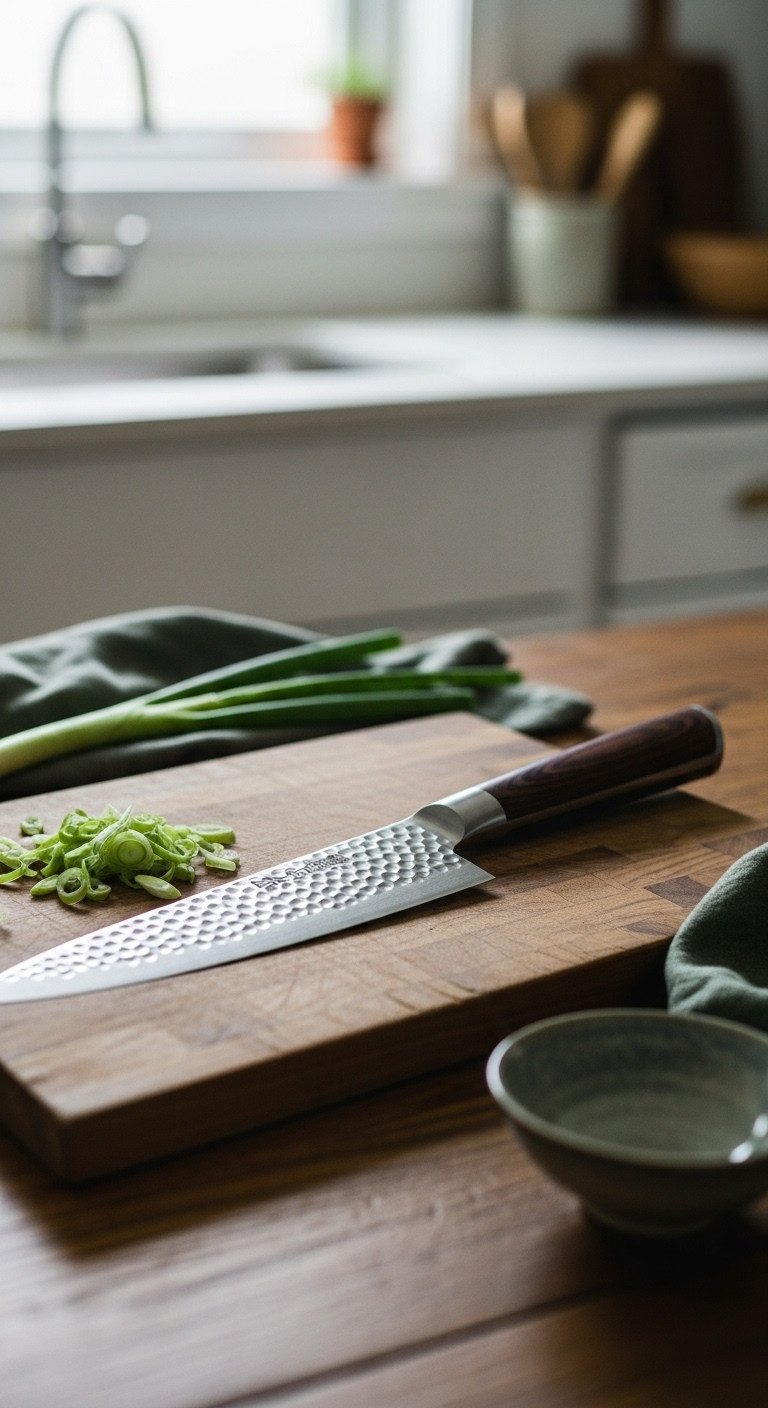
Pin this essential knife guide to your ‘Dream Kitchen’ board!
A high-quality Japanese chef’s knife is essential because its hard, thin, and razor-sharp blade allows for incredible precision, which is fundamental to Japanese cooking. The two most popular styles are the Santoku and the Gyuto. The Santoku, meaning “three virtues,” is an all-purpose knife excellent for slicing, dicing, and mincing. Its sheepsfoot blade profile and flatter edge are perfect for clean, downward chops. The Gyuto is the Japanese equivalent of a classic Western chef’s knife, featuring a more pronounced curve that allows for a rocking motion. Both are crafted from high-carbon steel that holds a sharper edge for longer than most Western knives.
- Materials Needed: 1 Japanese Chef’s Knife (Santoku recommended for versatility), 1 large carrot, cutting board.
- Step-by-Step Directions:
- Hold the knife with a firm “pinch grip,” pinching the base of the blade between your thumb and forefinger for maximum control.
- Curl the fingers of your other hand into a “claw grip” to protect your fingertips while holding the carrot.
- Use a smooth, forward-and-down slicing motion. The Santoku’s flatter blade is excellent for this chopping motion, unlike the rocking motion used with Western knives.
- Notice how a high-quality knife with a Granton edge (dimples) helps the carrot slices fall away cleanly without sticking.
Pro-Tip: Never put a quality Japanese knife in the dishwasher. The high heat and harsh detergents can damage the high-carbon steel blade and the wooden handle. Always hand wash and dry immediately.
2. Perfect Grains Every Time: Electric Rice Cooker (Suihanki)
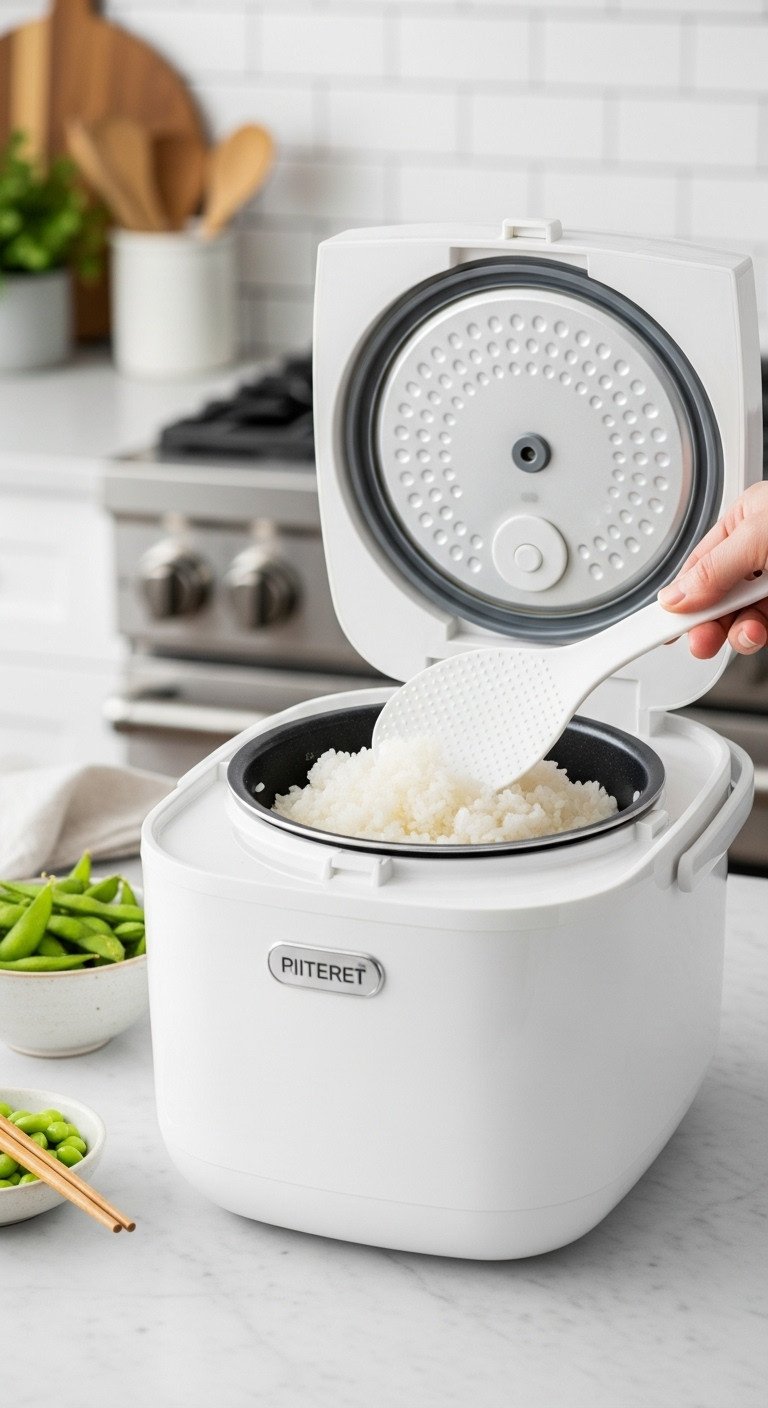
Save this tip for flawless rice to your ‘Weeknight Meals’ board!
An electric rice cooker is considered essential because it automates the cooking process to produce perfectly fluffy rice with consistent results every time. In Japan, where rice is a cornerstone of almost every meal, consistency is key. Modern Japanese rice cookers are sophisticated appliances with multiple settings for different types of rice (white, brown, sushi, porridge) and functions that control temperature and time with precision. This technology eliminates guesswork, ensuring the rice is steamed to the perfect texture without being too wet or too dry.
- Materials Needed: 1 cup Japanese short-grain rice, 1 modern electric rice cooker with specific settings for different rice types.
- Step-by-Step Directions:
- Measure the rice accurately using the cup provided with the cooker.
- Wash the rice in a separate bowl until the water runs mostly clear. This removes excess starch for a fluffier texture.
- Place the washed rice in the cooker’s inner pot and add water to the corresponding fill line. These lines are precisely calibrated for perfect results.
- Select the correct setting (e.g., ‘White Rice’ or ‘Sushi Rice’) and press start. The machine handles the rest, from soaking to steaming.
Pro-Tip: Once the rice cooker finishes, let the rice rest on the “keep warm” setting for 10-15 minutes before opening the lid. This allows the moisture to distribute evenly, resulting in perfectly fluffy grains from top to bottom.
3. The Flavor Maximizer: Suribachi & Surikogi (Mortar & Pestle)
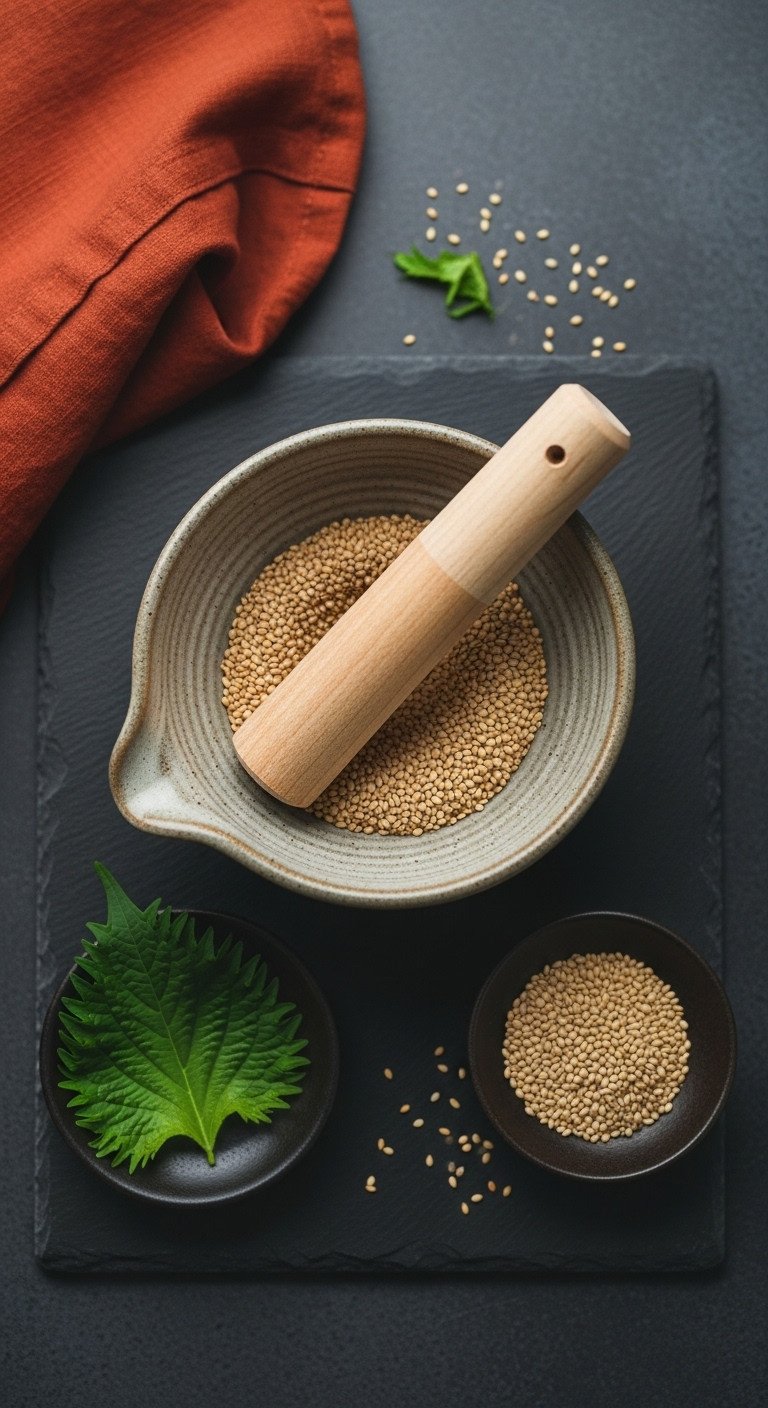
Pin this traditional tool for your ‘Authentic Recipes’ board!
The Suribachi and Surikogi function as a specialized mortar and pestle designed to efficiently grind ingredients like sesame seeds, releasing their aromatic oils for maximum flavor. The Suribachi is a ceramic bowl with sharp, unglazed grooves on the inside (called kushinome), and the Surikogi is a wooden pestle. Unlike a food processor that can overheat and dull flavors, or a smooth stone mortar that crushes, the Suribachi’s grooves bruise and grind ingredients, creating an intensely fragrant paste that is essential for authentic gomae (sesame dressing) and other sauces.
- Materials Needed: 1 Suribachi and Surikogi set, 2 tablespoons of toasted sesame seeds.
- Step-by-Step Directions:
- Place the toasted sesame seeds into the Suribachi bowl.
- Hold the Surikogi pestle firmly and press the seeds against the sharp ceramic grooves.
- Grind in a circular motion. The grooves will efficiently break down the seeds, releasing their aromatic oils.
- Continue grinding until you reach your desired consistency, from a coarse powder to a fine paste for dressings. You’ll notice an incredible aroma that a food processor can’t replicate.
Lesson Learned: Don’t use a regular stone mortar and pestle for this. The Suribachi’s unglazed, grooved interior is specifically designed to bruise and grind ingredients like sesame without turning them into a heavy, oily paste.
4. The Broth Purifier: Fine Mesh Skimmer (Aku Tori)
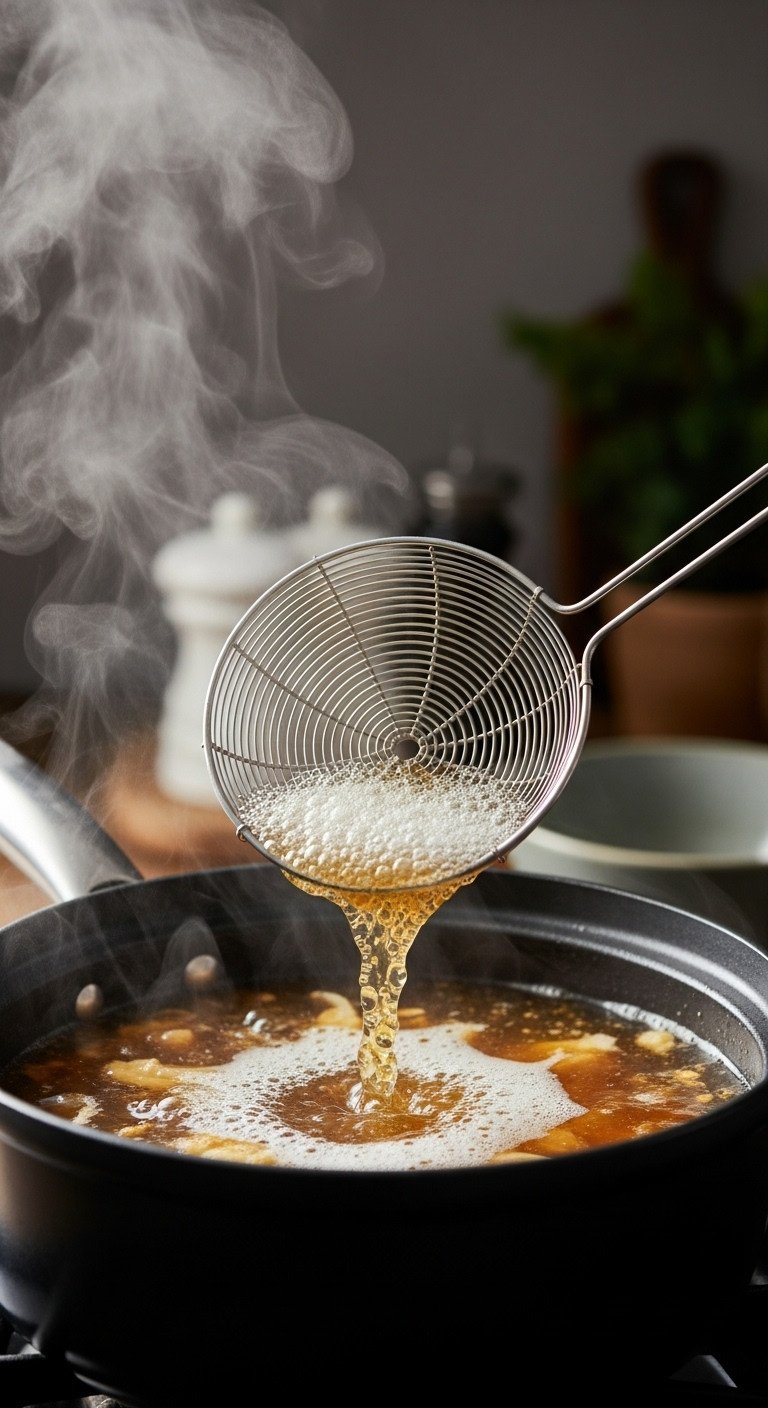
Save this secret for clear, beautiful soups!
A fine mesh skimmer, or Aku Tori, is crucial for achieving the crystal-clear, refined broths that are a hallmark of Japanese cuisine. As stocks and soups simmer, impurities and foam (called aku) rise to the surface. This skimmer is designed with an ultra-fine mesh that effectively lifts off even the smallest particles of scum and excess fat while leaving the precious broth behind. Removing the aku results in a cleaner taste and a more appealing, professional appearance for dishes like suimono (clear soup) and nabemono (hot pot).
- Materials Needed: 1 fine mesh skimmer, 1 pot of simmering stock or soup (e.g., dashi or chicken stock).
- Step-by-Step Directions:
- As your broth comes to a simmer, you will see foam and impurities (called ‘aku’ in Japanese) rise to the surface.
- Gently guide the fine mesh skimmer across the surface of the liquid.
- The ultra-fine mesh is designed to capture even the smallest particles of scum and fat while leaving the clear broth behind.
- Tap the skimmer on the side of a small bowl of water to clean it between skims. Repeat until the surface is clear for a refined flavor and appearance.
Pro-Tip: A fine mesh skimmer is far more effective than a regular spoon, which tends to scoop up too much broth along with the scum. It’s the key to the delicate, clean taste of professional-quality Japanese soups.
5. The Gentle Cooker: Otoshibuta (Japanese Drop Lid)
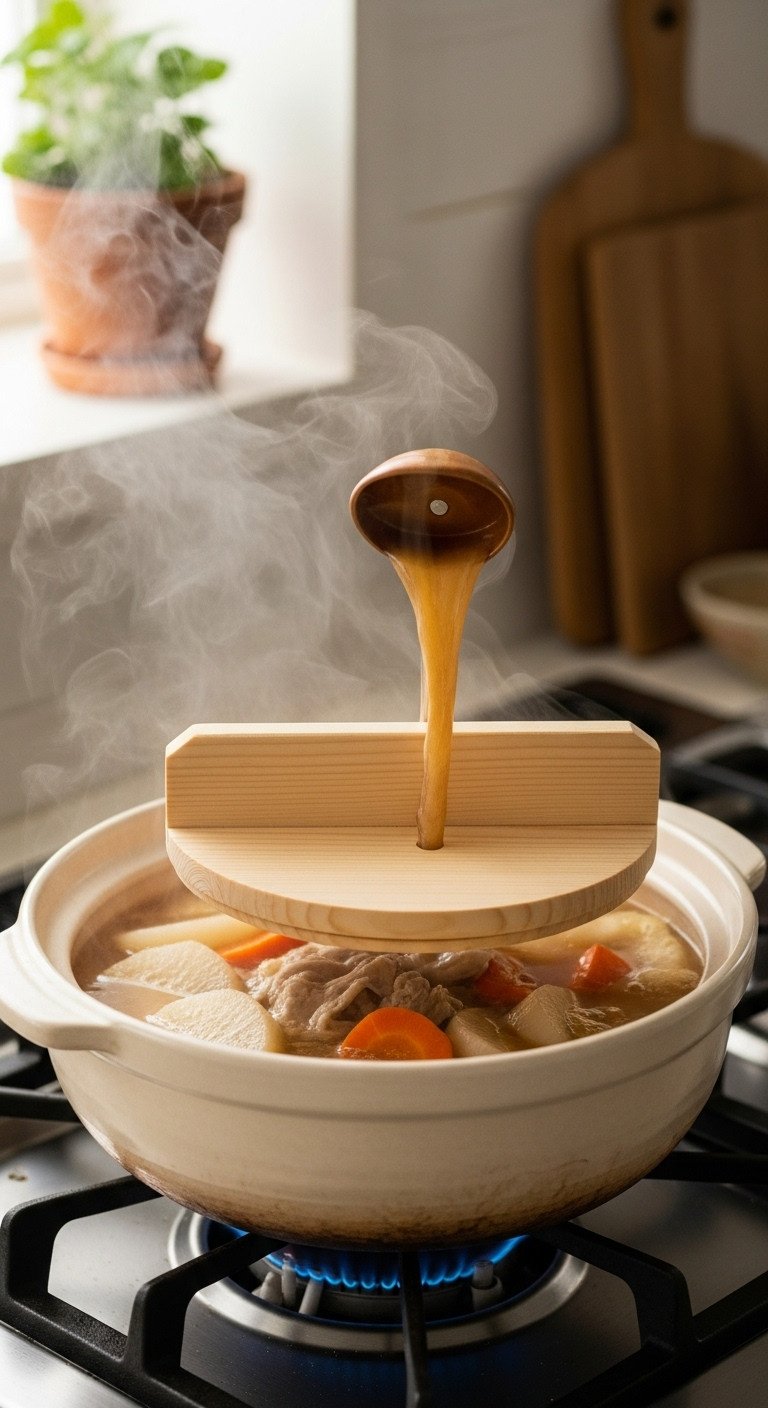
Pin this clever Japanese cooking hack!
An Otoshibuta, or drop lid, is a unique tool used in simmered dishes (nimono) to ensure ingredients cook evenly and absorb flavor more effectively. Unlike a regular lid that sits on the rim of the pot, the Otoshibuta rests directly on the surface of the food. This clever design forces the simmering liquid to circulate, prevents ingredients from moving around and breaking apart, and reduces the amount of liquid needed, resulting in a more concentrated sauce. It’s essential for classic dishes like Nikujaga (meat and potato stew) and braised daikon.
- Materials Needed: 1 Otoshibuta, 1 pot with ingredients for a simmered dish (e.g., potatoes, carrots, and meat for Nikujaga).
- Step-by-Step Directions:
- Place your ingredients and simmering liquid in a pot and bring to a boil.
- Reduce the heat to a gentle simmer.
- Place the Otoshibuta directly on top of the ingredients, so it floats on the surface of the liquid.
- The lid ensures the liquid circulates evenly, keeps the ingredients submerged for consistent flavor absorption, and prevents delicate items from breaking apart. Use a wooden Otoshibuta for a traditional feel or an adjustable stainless steel version for versatility.
Lesson Learned: If you don’t have an Otoshibuta, you can make a temporary one by cutting a circle out of parchment paper, folding it, and cutting a small hole in the center. However, a proper wooden or steel lid is heavier and more effective.
6. The Sushi Master’s Bowl: Hangiri (Sushi Oke)
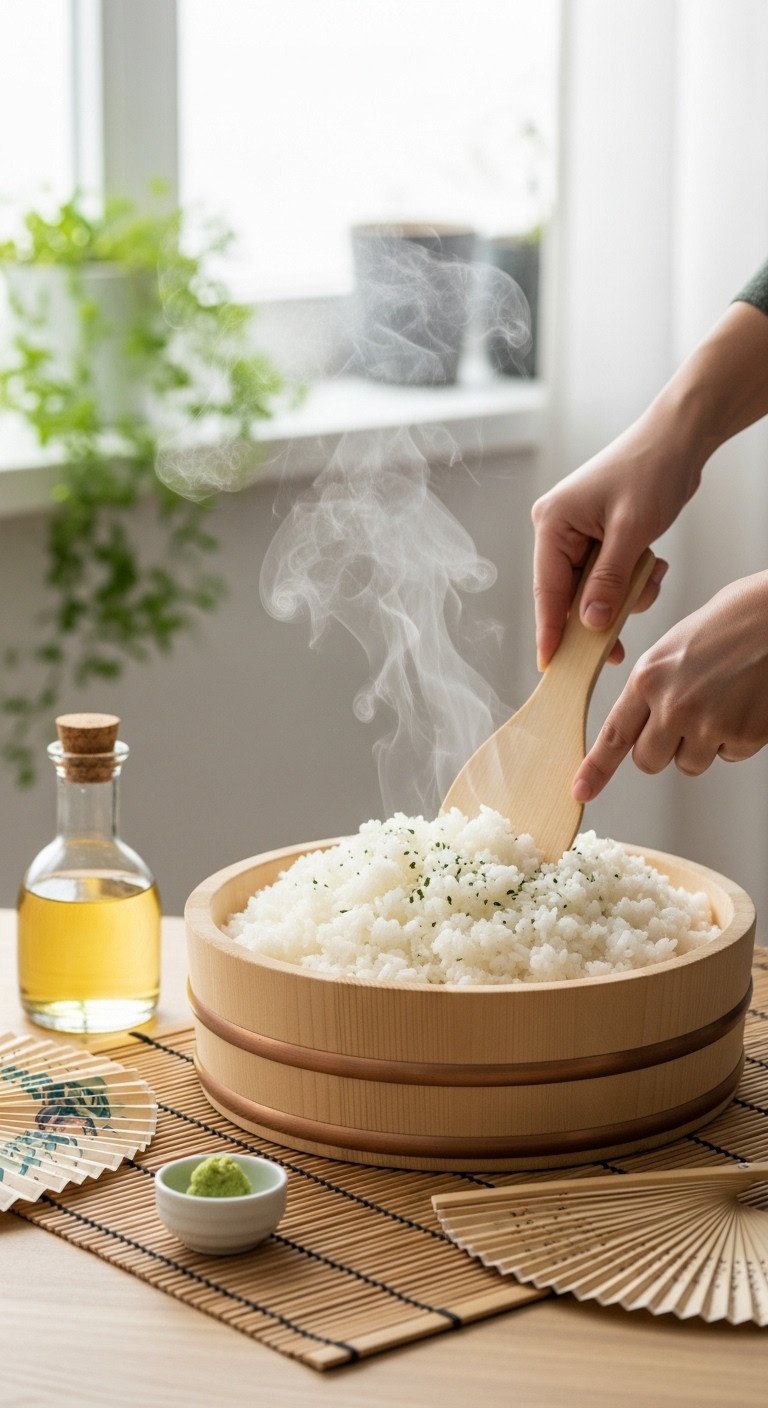
Save this for your next sushi night!
A Hangiri, a large, flat-bottomed wooden bowl, is specifically designed for cooling and seasoning rice to achieve the perfect texture for sushi. The key lies in its construction. Traditionally made from uncoated cypress wood, the Hangiri’s large surface area allows steam to escape quickly, while the porous wood absorbs excess moisture from the cooked rice. This prevents the rice from becoming gummy as you fold in the seasoned vinegar, resulting in glossy, distinct grains that are the foundation of high-quality sushi.
- Materials Needed: 1 Hangiri, freshly cooked short-grain rice, sushi vinegar mixture, rice paddle.
- Step-by-Step Directions:
- Briefly moisten the inside of the Hangiri with water and wipe it dry. This prevents the rice from sticking.
- Immediately transfer the hot, cooked rice into the Hangiri. The large, flat surface area is key for rapid cooling.
- Pour the sushi vinegar mixture evenly over the rice paddle onto the rice.
- Using the paddle, “cut” and fold the rice in a slicing motion. Do not stir or mash it. The porous cypress wood of a quality Hangiri absorbs excess moisture, resulting in perfectly seasoned, glossy rice that isn’t sticky or mushy.
Pro-Tip: While mixing the rice, use a fan (or a magazine in a pinch) to cool it down quickly. This rapid cooling process is what gives sushi rice its characteristic sheen.
7. The Chef’s Fingers: Long Cooking Chopsticks (Saibashi)
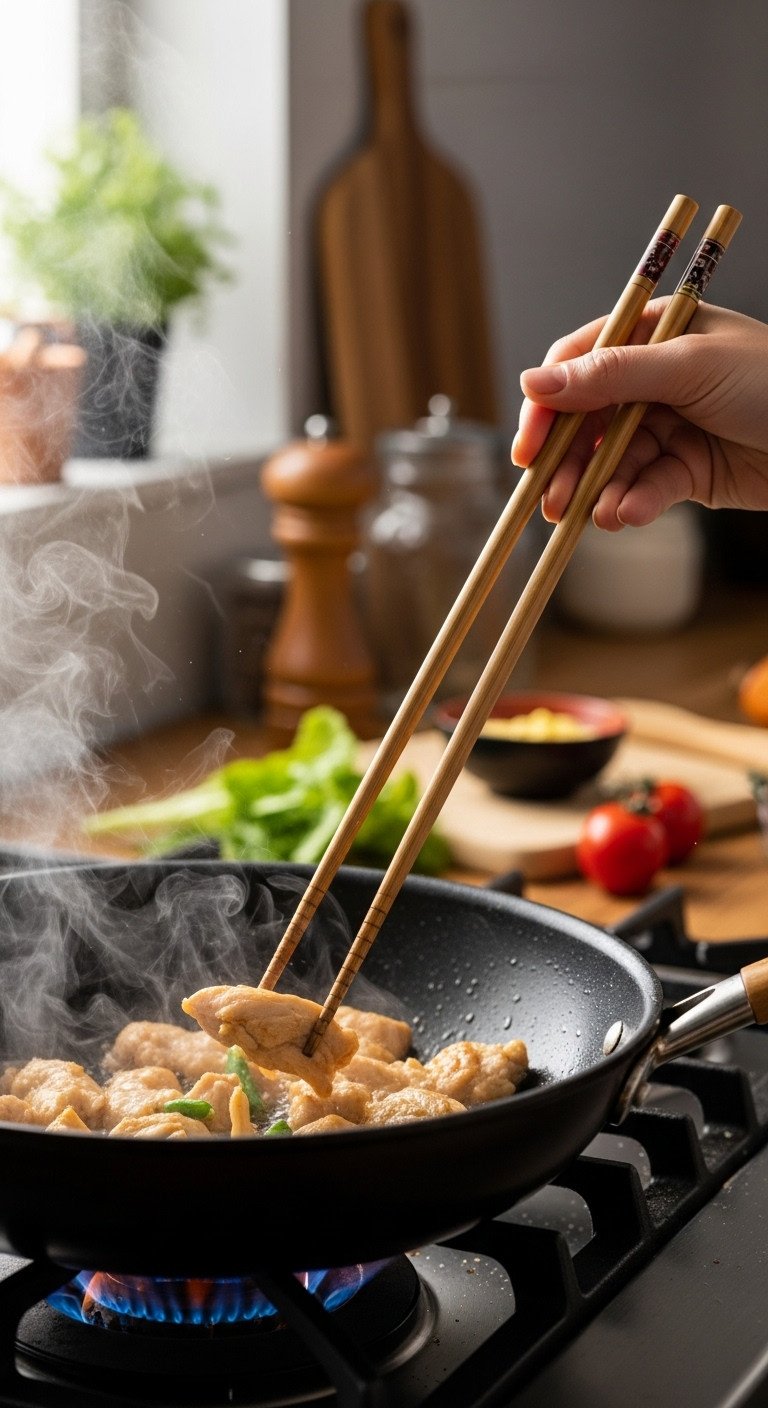
Pin this versatile kitchen tool idea!
Saibashi are long cooking chopsticks that act as a precise and versatile extension of the chef’s hands, perfect for tasks from stir-frying to delicate plating. Significantly longer than regular chopsticks (often 30cm or more), their length keeps your hands safely away from the heat of a hot wok, deep-fryer, or pot. They offer far more dexterity than tongs or a spatula, allowing you to turn a single piece of tempura, delicately scramble eggs, or artfully arrange a garnish with surgical precision.
- Materials Needed: 1 pair of Saibashi (at least 30cm long).
- Step-by-Step Directions:
- For Stir-Frying: Use them to deftly move and separate ingredients in a hot wok, providing more precision than a clumsy spatula.
- For Deep-Frying: Their length keeps your hands safely away from splattering oil as you add, turn, and remove items like tempura.
- For Plating: Arrange delicate garnishes or noodles with surgical precision.
- For Scrambling Eggs: Use them to create delicate, fluffy curds for Japanese-style scrambled eggs (Iri Tamago).
Lesson Learned: Many Saibashi come with the top ends tied together with a string. Keep the string on! It prevents you from losing one and makes them easy to hang for storage.
8. The Zesty Grater: Japanese Grater (Oroshigane)
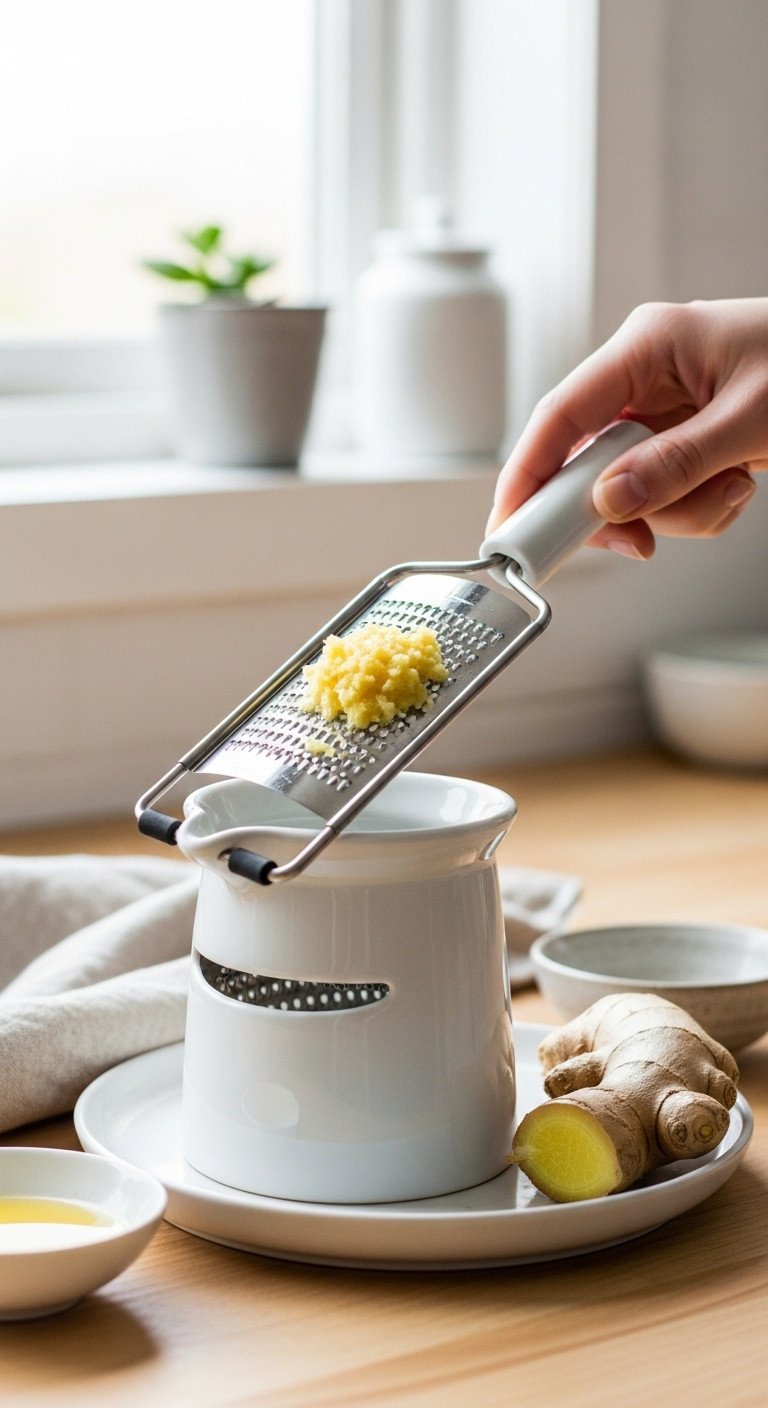
Save this for adding maximum flavor to your dishes!
A Japanese grater, or Oroshigane, is designed with extremely fine, sharp teeth to produce a juicy, flavorful paste from ingredients like ginger, daikon, and wasabi. Unlike Western graters or microplanes that create shreds, an Oroshigane ruptures the cell walls of the ingredient. This process releases significantly more juice and aromatic compounds, resulting in a much more potent and intense flavor. Many ceramic versions even have a moat to collect the precious juice, which is perfect for adding to marinades, sauces, and broths.
- Materials Needed: 1 Japanese grater (ceramic is great for juicy results), 1 knob of fresh ginger.
- Step-by-Step Directions:
- Peel the ginger.
- Rub the ginger in a circular motion against the grater’s very fine, sharp teeth.
- Unlike a microplane which creates shreds, an Oroshigane produces a wet, fibrous paste, rupturing the cell walls to release maximum flavor and juice.
- Many ceramic graters have a built-in moat to collect the flavorful juice, which can be added to marinades and dipping sauces.
Pro-Tip: For grating wasabi or daikon, a traditional Oroshigane covered in sharkskin (same-kawa) produces the finest, most pungent paste, but a high-quality ceramic or copper grater is an excellent and more accessible alternative for home use.
9. The Communal Centerpiece: Donabe (Earthenware Pot)
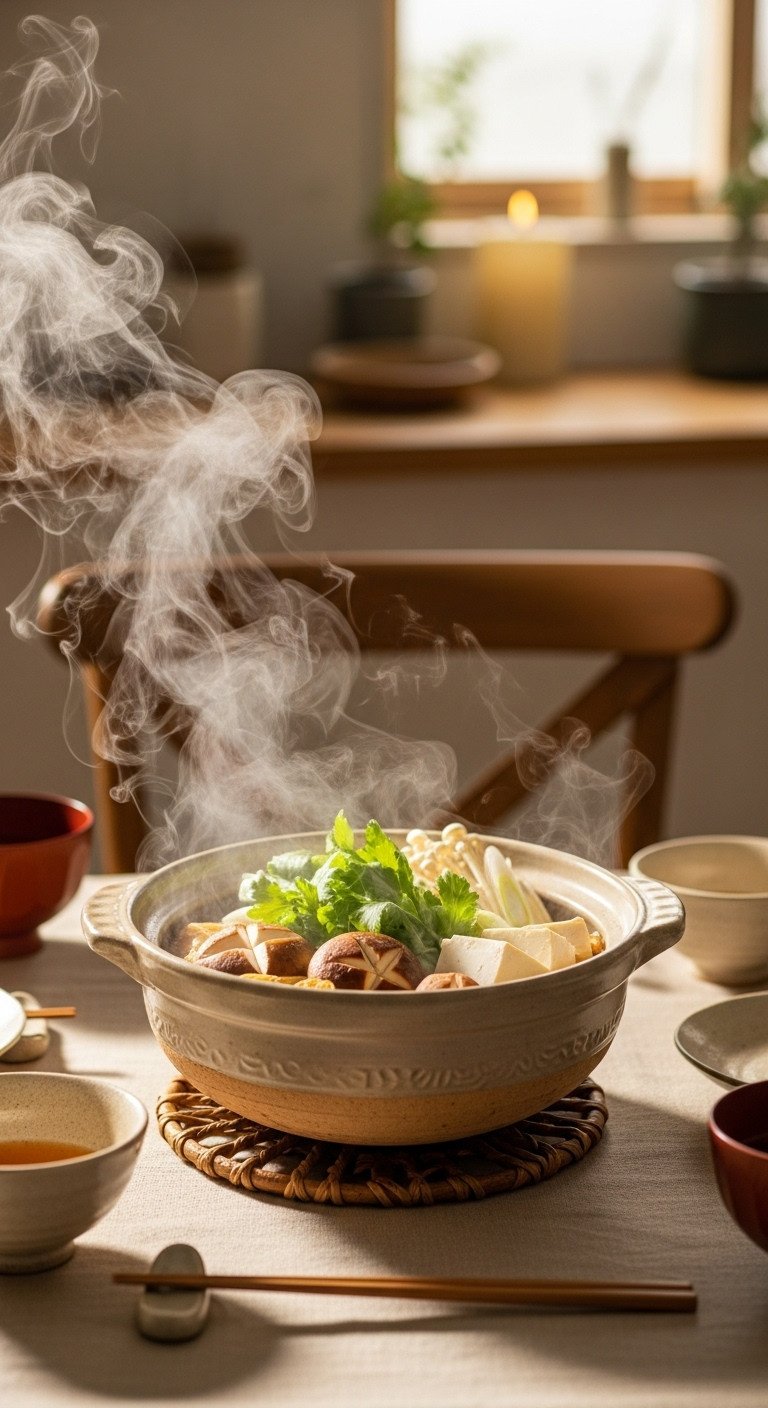
Pin this cozy meal idea for your next dinner party!
A Donabe is a traditional Japanese earthenware pot that is prized for its superior heat retention, making it perfect for slow-cooking and serving communal hot pot dishes (nabemono). Made from special clay, a Donabe heats up slowly and gently, and then retains that heat for a long time after being removed from the stove. This quality makes it ideal for table-side cooking, as it keeps the broth at a gentle, consistent simmer throughout the meal. Cooking and eating from a Donabe is a warm, shared experience that is central to Japanese home-style dining.
- Materials Needed: 1 Donabe pot, broth, assorted vegetables (napa cabbage, mushrooms), tofu, and thinly sliced meat.
- Step-by-Step Directions:
- Before first use, “season” your new Donabe by making a simple rice porridge in it (a process called ‘medome’). This seals the porous clay.
- To make hot pot, fill the Donabe with broth and bring it to a simmer on the stovetop.
- Transfer the pot to a portable burner on the dining table.
- Guests cook their own ingredients in the communal pot. The Donabe’s exceptional heat retention keeps the broth at a perfect, gentle simmer throughout the meal, creating a wonderful shared dining experience.
Lesson Learned: Avoid drastic temperature changes with your Donabe. Never place a hot pot on a cold, wet surface or fill a cold pot with boiling liquid, as the clay can crack. Always heat it gently.
Key Takeaways: Your Quick Guide to Japanese Kitchenware
- Japanese Knife (Santoku): For unparalleled precision in slicing, dicing, and mincing, forming the foundation of Japanese prep work.
- Electric Rice Cooker: To achieve consistently perfect, fluffy rice, the cornerstone of most Japanese meals, with zero effort.
- Suribachi (Mortar & Pestle): To unlock the deepest, most aromatic flavors from seeds and spices for authentic dressings and pastes.
- Donabe (Earthenware Pot): For superior heat retention in communal hot pots and stews, turning a meal into an experience.
- Saibashi (Long Chopsticks): For safe, precise handling of ingredients in hot pots, pans, and fryers, acting as a natural extension of the chef’s hands.
People Also Ask About Japanese Kitchenware
What is the most essential Japanese kitchen tool?
While it depends on what you cook most, a high-quality Japanese chef’s knife, either a Santoku or Gyuto, is universally considered the single most essential tool. Precision cutting is fundamental to Japanese cuisine, and a sharp, well-balanced knife makes all preparation tasks easier, safer, and more efficient.
What are the best Japanese kitchenware brands?
For knives, brands like Shun, Global, and Korin are highly reputable. For rice cookers, Zojirushi and Tiger are industry leaders. For high-quality Donabe pots and ceramic ware, look for items made in Iga or Banko, famous regions for Japanese pottery. Generally, seeking brands that specialize in a particular item yields the best results.
Can I use regular kitchen tools for Japanese cooking?
Yes, you can prepare many Japanese dishes with standard Western equipment. However, specialized tools like a Suribachi, Otoshibuta, or Hangiri are designed to achieve specific textures and flavors that are difficult to replicate. Using them can significantly elevate the authenticity and quality of your final dish.
Where can I buy authentic Japanese kitchenware?
You can find authentic kitchenware at specialty Japanese markets, high-end kitchen supply stores, and online retailers. Websites like Korin, MTC Kitchen, and Globalkitchen Japan specialize in professional-grade Japanese tools and ship worldwide. Many high-quality items from reputable brands are also available on Amazon.
Final Thoughts
Building a collection of Japanese kitchenware is a journey, not a race. Start with one or two tools that resonate with the dishes you love to cook, whether it’s the precision of a Santoku or the communal joy of a Donabe. By incorporating these purpose-built items into your kitchen, you’re not just acquiring tools; you’re embracing a tradition of mindfulness and craftsmanship that makes every meal more special. Which tool are you most excited to try first? Let us know in the comments below
Last update on 2025-10-15 at 12:01 / Affiliate links / Images from Amazon Product Advertising API
